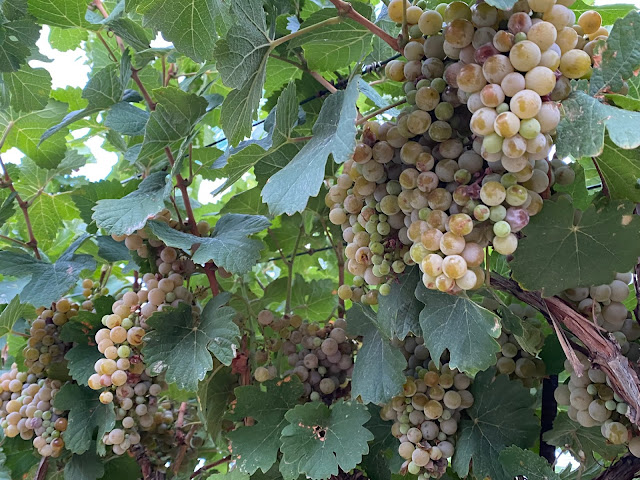Study of 'inactivated yeast products' on grape quality at Fabian Garcia, Agriculture Science Center
G. Giese1, Ciro Velasco-Cruz2, and D. Goodrich3
1 Asst. Professor, Extension Viticulture Specialist, New Mexico State University,
Department of Extension Plant Sciences, Los Lunas, NM 87031
2 Visiting Statistical Scientist, New Mexico State University, Department of Extension
Plant Sciences, Las Cruces, NM 87031, Research Professor, Estadistica, Colegio de
Posgraduados, Carretera Mexico-Texcoco Km. 36.5, Montecillo, Texcoco 56230,
Estado de Mexico, Mexico
3 Program Coordinator, New Mexico State University, Department of Extension Plant
Sciences, Las Cruces, NM 88003
Introduction and Potential Impact: Grapes grown in warm climates typically achieve desired sugar levels in advance of phenolic maturity (Gladstones, 2011). Furthermore, primary chemistry attributes: soluble solids, titratable acidity and pH, often ‘peak’ prior to development of many flavor and aroma precursors. Harvest decisions based on potential alcohol contingent on berry sugar level is not conducive to optimum wine quality. Tannins and anthocyanins are phenolic compounds essential for red wine color and astringency, considered essential to wine ‘quality’. Glutathione, is a thiol, a sulfur containing compound, that is important as an antioxidant and act to preserve aroma and color. It commonly occurs in aromatic white wine grapes.
Recently, foliar-applied nitrogen and inactivated yeast products have been tested for their impact on yield components and grape composition, and in some cases to evaluate their influence on free and bound volatiles.
Winegrowers in New Mexico seek to optimize berry composition and wine quality of grapes grown in a hot, arid environment. We evaluated the effects of a commercial “activated yeast” product (LalVigne Aroma and LalVigne Mature) on six established Vitis vinifera cultivars under the hot, arid climate conditions of southern New Mexico. This information will begin to clarify and quantify the potential benefit and economic feasibility of optimized berry and wine quality via foliar application of these products at a set crop load across several varieties.
Methods: The study was established in 2018 at the Fabian Garcia Agriculture Science Center in Las Cruces NM. Six Vitis vinifera varieties: Picpoul blanc, Gewürztraminer, Negro Amaro, Durif, Cabernet Sauvignon and Montepulciano (grafted to 101-14 rootstock, V. riparia x V. rupestris) The vineyard was planted in 2009 at a spacing of 4 ft x 10 ft. Each cultivar occurred in two rows, with one row trained to a modified VSP (vertical shoot positioned) trellis with a single pair of catch wires or and the second row trained to a single high-wire “sprawl” trellis system. All treatments were adjusted to a predetermined shoot/crop level of ~16 shoots/~32 clusters per vine, imposed when shoots reached ~10 cm length with 5 leaves separated and inflorescence clear (modified E-L stage 12, Coombe 1995) and cluster thinning imposed at E-L stage 27, fruit set). The experimental replicate plots consisted of four test vines arranged in GRCBD. Data collected included fruit yield, cluster and berry weight and composition (primary chemistry and either total phenolics (reds) or glutathione (whites)) and dormant pruning weights.
Results: Experimental treatments were initiated in the spring of 2018. We have collected various amounts of data in 2018 and 2019 and will complete the study this year, 2020.
References:
Bell, S. J., and P.A. Henschke. 2005. Implications of nitrogen nutrition for grapes, fermentation and wine. Aust. J. Grape and Wine Res., 11:242-295.
Coombe, B.G. 1995. Adoption of a system for identifying grapevine growth stages. Aust. J. Grape Wine Res. 1:104-110.
Gladstones, J. 2011.Wine, Terroir and Climate Change. Kent Town, Australia, Wakefield Press.
Jackson, D.I., and P.B. Lombard. 1993. Environmental and management practices affecting grape composition and wine quality – a review. Am. J. Enol. Vitic. 44:411-430.
Jackson, R.S. 2014.Wine Science Principles and Practices, 4th Edition, Academic Press, London.
Keller, M. 2010. The Science of Grapevines, Anatomy and Physiology. Academic Press, London.
 |
| Jacque Cormier, NMSU viticulture graduate student works to harvest Gewurztraminer at the Fabian Garcia ASC in Las Cruces, NM, July 22, 2020. |


No comments:
Post a Comment